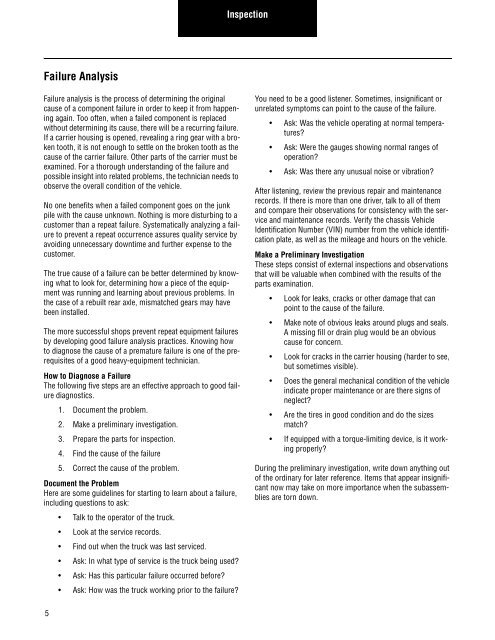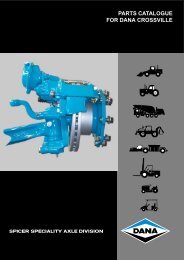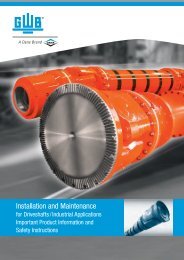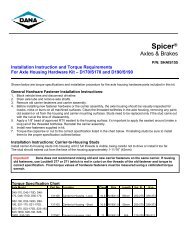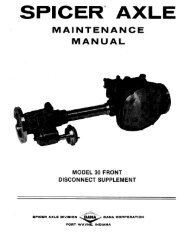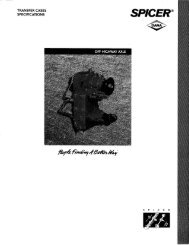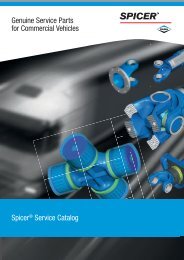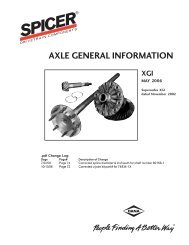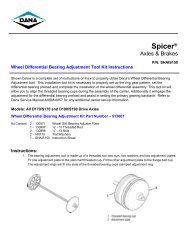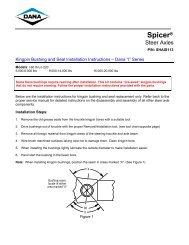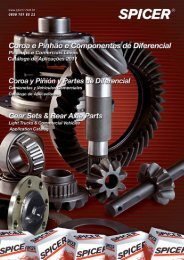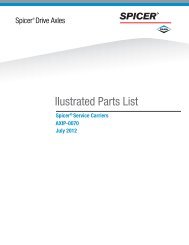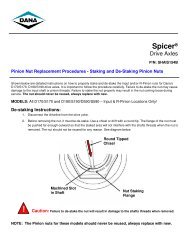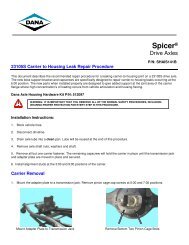Single Reduction & Single Reduction with Differential Lock - Spicer
Single Reduction & Single Reduction with Differential Lock - Spicer
Single Reduction & Single Reduction with Differential Lock - Spicer
You also want an ePaper? Increase the reach of your titles
YUMPU automatically turns print PDFs into web optimized ePapers that Google loves.
Failure Analysis<br />
Failure analysis is the process of determining the original<br />
cause of a component failure in order to keep it from happening<br />
again. Too often, when a failed component is replaced<br />
<strong>with</strong>out determining its cause, there will be a recurring failure.<br />
If a carrier housing is opened, revealing a ring gear <strong>with</strong> a broken<br />
tooth, it is not enough to settle on the broken tooth as the<br />
cause of the carrier failure. Other parts of the carrier must be<br />
examined. For a thorough understanding of the failure and<br />
possible insight into related problems, the technician needs to<br />
observe the overall condition of the vehicle.<br />
No one benefits when a failed component goes on the junk<br />
pile <strong>with</strong> the cause unknown. Nothing is more disturbing to a<br />
customer than a repeat failure. Systematically analyzing a failure<br />
to prevent a repeat occurrence assures quality service by<br />
avoiding unnecessary downtime and further expense to the<br />
customer.<br />
The true cause of a failure can be better determined by knowing<br />
what to look for, determining how a piece of the equipment<br />
was running and learning about previous problems. In<br />
the case of a rebuilt rear axle, mismatched gears may have<br />
been installed.<br />
The more successful shops prevent repeat equipment failures<br />
by developing good failure analysis practices. Knowing how<br />
to diagnose the cause of a premature failure is one of the prerequisites<br />
of a good heavy-equipment technician.<br />
How to Diagnose a Failure<br />
The following five steps are an effective approach to good failure<br />
diagnostics.<br />
5<br />
1. Document the problem.<br />
2. Make a preliminary investigation.<br />
3. Prepare the parts for inspection.<br />
4. Find the cause of the failure<br />
5. Correct the cause of the problem.<br />
Document the Problem<br />
Here are some guidelines for starting to learn about a failure,<br />
including questions to ask:<br />
Talk to the operator of the truck.<br />
Look at the service records.<br />
Find out when the truck was last serviced.<br />
Ask: In what type of service is the truck being used?<br />
Ask: Has this particular failure occurred before?<br />
Ask: How was the truck working prior to the failure?<br />
Inspection<br />
You need to be a good listener. Sometimes, insignificant or<br />
unrelated symptoms can point to the cause of the failure.<br />
Ask: Was the vehicle operating at normal temperatures?<br />
Ask: Were the gauges showing normal ranges of<br />
operation?<br />
Ask: Was there any unusual noise or vibration?<br />
After listening, review the previous repair and maintenance<br />
records. If there is more than one driver, talk to all of them<br />
and compare their observations for consistency <strong>with</strong> the service<br />
and maintenance records. Verify the chassis Vehicle<br />
Identification Number (VIN) number from the vehicle identification<br />
plate, as well as the mileage and hours on the vehicle.<br />
Make a Preliminary Investigation<br />
These steps consist of external inspections and observations<br />
that will be valuable when combined <strong>with</strong> the results of the<br />
parts examination.<br />
Look for leaks, cracks or other damage that can<br />
point to the cause of the failure.<br />
Make note of obvious leaks around plugs and seals.<br />
A missing fill or drain plug would be an obvious<br />
cause for concern.<br />
Look for cracks in the carrier housing (harder to see,<br />
but sometimes visible).<br />
Does the general mechanical condition of the vehicle<br />
indicate proper maintenance or are there signs of<br />
neglect?<br />
Are the tires in good condition and do the sizes<br />
match?<br />
If equipped <strong>with</strong> a torque-limiting device, is it working<br />
properly?<br />
During the preliminary investigation, write down anything out<br />
of the ordinary for later reference. Items that appear insignificant<br />
now may take on more importance when the subassemblies<br />
are torn down.


